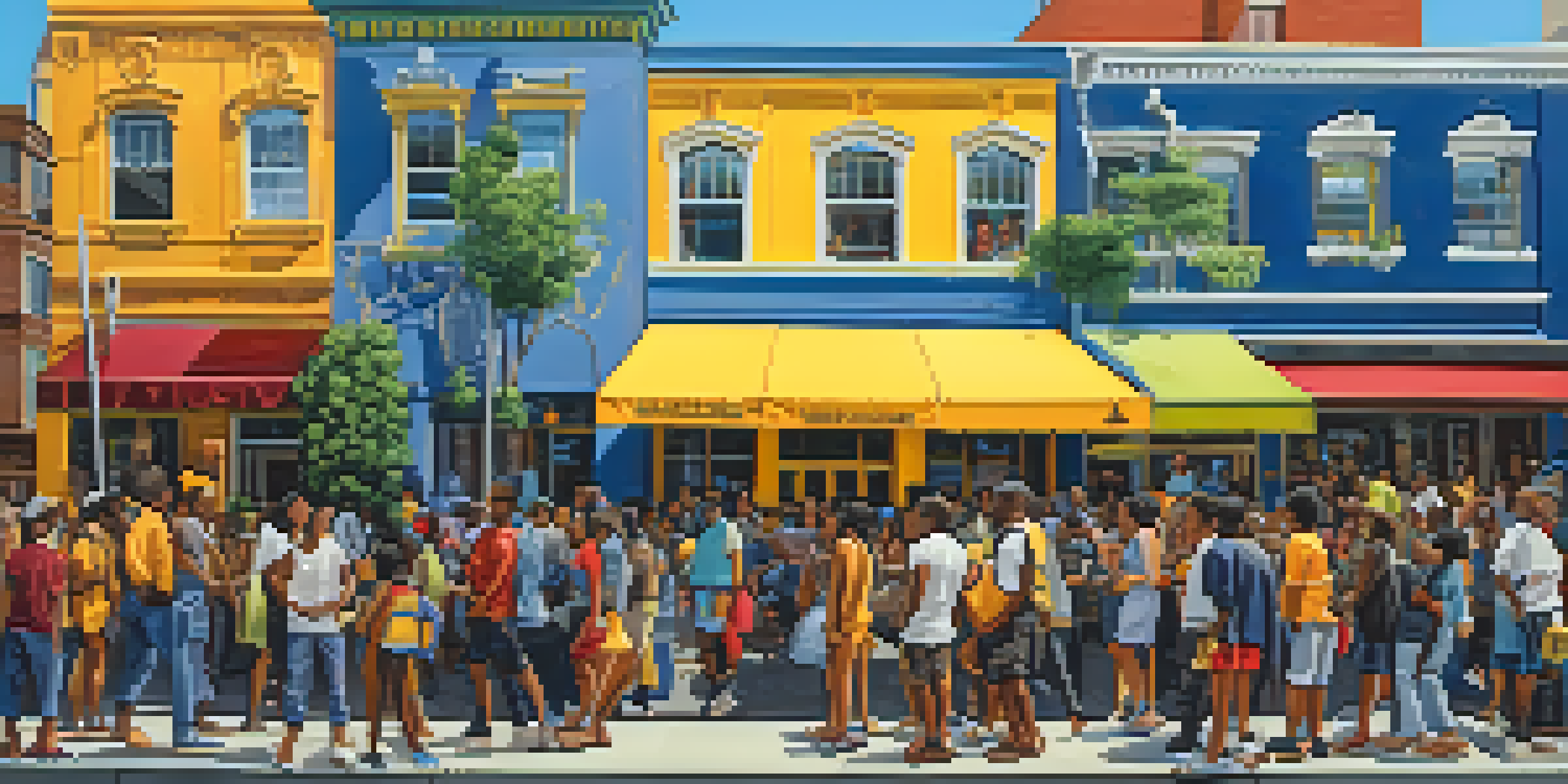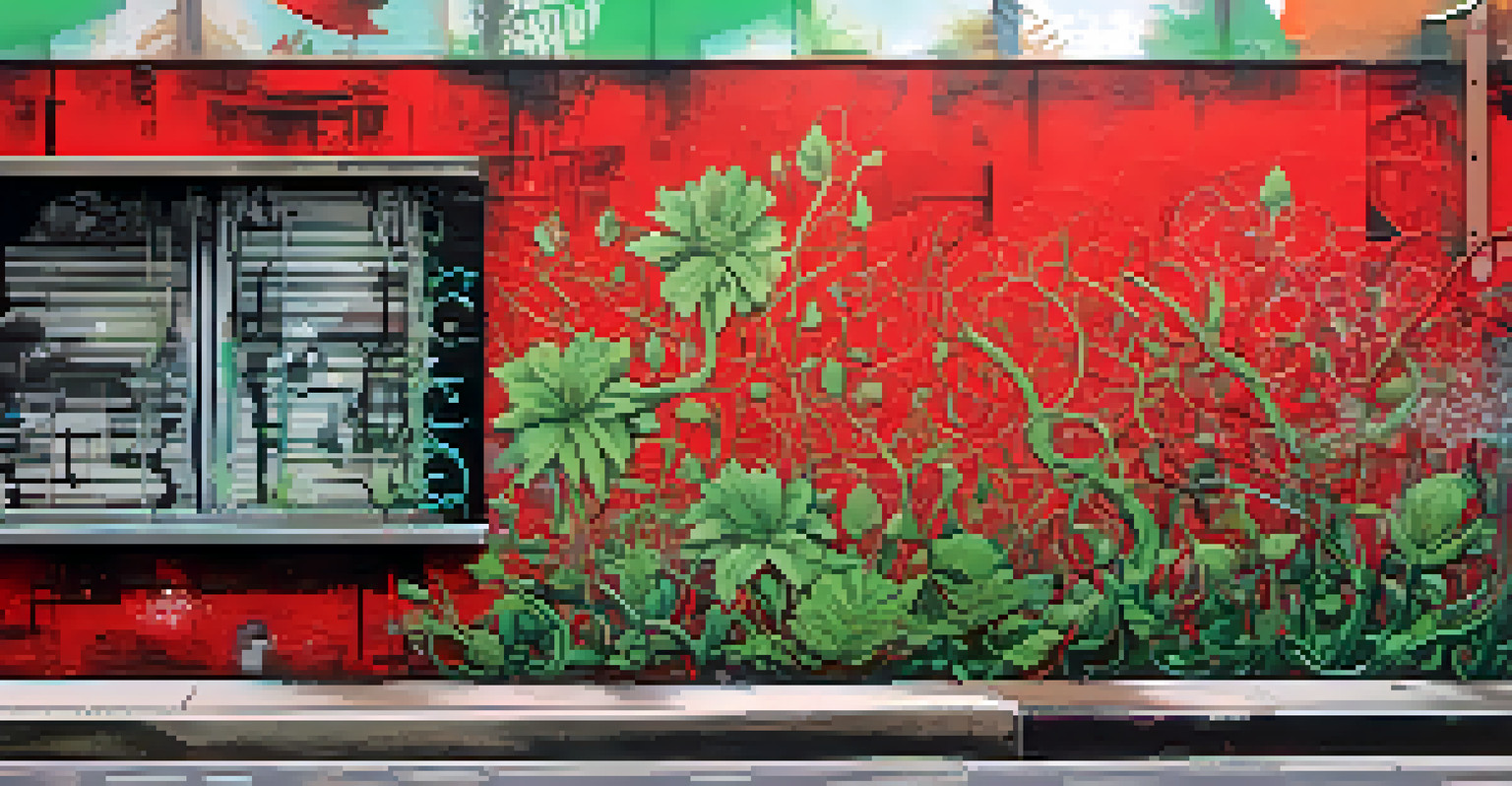Temporal Dynamics in Street Art: A Reflection of Society

Understanding Temporal Dynamics in Art
Temporal dynamics in art refers to how artistic expressions change over time, influenced by cultural, social, and political factors. This concept is especially significant in street art, where artists often reflect current events and societal issues. As society evolves, so do the messages and techniques used in street art, making it a living, breathing commentary on the world around us.
Art is the most beautiful of all lies; it is the truth of the moment, frozen in time.
For instance, a mural created in response to a political movement may take on new meanings as the political landscape changes. This fluid nature allows street art to remain relevant and impactful, resonating with audiences who experience these shifts. By examining the temporal aspects of street art, we can gain deeper insights into not just the art itself, but also the society that inspires it.
Ultimately, understanding these dynamics helps us appreciate the artistry involved, as well as the critical role that street art plays in documenting societal changes and challenges. It's like a time capsule that captures the spirit of the moment, providing a visual narrative of our collective experiences.
The Role of Street Art as Social Commentary
Street art often serves as a powerful form of social commentary, addressing issues such as inequality, injustice, and identity. Artists use public spaces to voice their opinions and provoke thought, making their work accessible to a broader audience. Unlike traditional art forms confined to galleries, street art reaches people in their everyday environments, fostering conversations around pressing societal issues.

Take, for example, the striking murals that emerged during the Black Lives Matter movement. These artworks not only reflected the urgency of the moment but also gave voice to marginalized communities, amplifying their stories. By engaging with current events, street artists create a dialogue that challenges viewers to reflect on their own beliefs and actions.
Street Art as Social Commentary
Street art serves as a powerful voice for societal issues, engaging the public in crucial conversations about inequality and injustice.
This dynamic interplay between art and society creates a vibrant tapestry of perspectives, each piece contributing to a larger narrative about our times. As street art continues to evolve, it remains a crucial medium for expressing dissent, solidarity, and hope in the face of adversity.
Historical Context: Street Art Through the Ages
To fully grasp the temporal dynamics of street art, it is essential to explore its historical context. Street art has roots in ancient civilizations, where markings on walls conveyed messages or commemorated events. Fast forward to the late 20th century, and we see the rise of graffiti as a form of rebellion, often associated with hip-hop culture and urban identity.
Street art is a way to communicate with the public; it is the voice of the people, expressing their thoughts and struggles.
As society progressed into the 21st century, street art began to shift from mere vandalism to a recognized art form. Artists like Banksy and Shepard Fairey emerged, using their platforms to address global issues while gaining mainstream recognition. This evolution highlights how street art adapts to cultural shifts, reflecting the changing values and priorities of society.
Understanding this historical backdrop allows us to appreciate the layers of meaning embedded in contemporary street art. Each piece carries echoes of the past while responding to the current moment, reinforcing the idea that art is an ongoing dialogue with history.
Technological Advances and Street Art's Evolution
The advent of technology has significantly influenced the creation and dissemination of street art. Digital tools allow artists to experiment with new techniques and styles that were previously unattainable, such as augmented reality installations. This innovation not only enhances the artistic experience but also broadens the reach of street art, connecting artists with audiences on a global scale.
Furthermore, social media platforms have become vital for street artists, allowing them to share their work instantly and engage with followers. This immediate feedback loop can influence the direction of their future projects, showcasing how technology shapes artistic dynamics. As artists adapt to these advancements, their work becomes a reflection of both technological progress and societal trends.
Historical Evolution of Street Art
Understanding the historical context of street art reveals its transformation from vandalism to a recognized art form that reflects cultural shifts.
In this way, street art evolves not just with societal changes but also with technological ones, creating a rich tapestry of interwoven influences. The result is a form of art that is as much about the message as it is about the medium through which it's expressed.
Cultural Significance of Street Art in Urban Spaces
Street art's cultural significance cannot be understated, especially in urban environments where it often thrives. Cities become canvases, with each mural and graffiti piece contributing to a sense of place and identity. This art form can beautify neglected areas, turning them into vibrant community spaces that invite engagement and reflection.
Moreover, street art often reflects the diverse voices within a community, celebrating local culture and history. It can serve as a catalyst for community pride, encouraging residents to take ownership of their surroundings. By showcasing local artists and themes, street art fosters a sense of belonging and collective identity among city dwellers.
As such, the presence of street art in urban spaces enriches the cultural landscape, reminding us that art can thrive outside traditional venues. It creates a dialogue between the past and present, inviting both residents and visitors to appreciate the stories that unfold on the streets.
Challenges and Controversies Surrounding Street Art
While street art is celebrated for its vibrancy and cultural significance, it is not without its challenges and controversies. One major issue is the fine line between art and vandalism, as many street artists find themselves at odds with city regulations. This tension raises questions about property rights, artistic freedom, and the value of public art.
Additionally, as street art gains recognition, commercialization threatens to dilute its message. Some artists express concern that their work may be co-opted by corporations seeking to capitalize on urban culture, stripping it of its original intent. This commodification can lead to a disconnect between the art and the communities that inspired it.
Technology's Impact on Street Art
Technological advancements have revolutionized street art, enabling new forms of expression and broadening artists' reach through social media.
Navigating these challenges requires a nuanced understanding of the role street art plays in society. While it can be a source of pride and expression, it must also contend with the realities of urban life and the complexities of artistic ownership.
The Future of Street Art: Trends and Innovations
As we look to the future, street art continues to evolve in exciting ways. Emerging trends include the integration of technology, such as projections and interactive installations, which enhance viewer engagement. Artists are also experimenting with mixed media, combining traditional techniques with digital elements to create multifaceted works that challenge perceptions.
Moreover, the global street art movement is gaining momentum, with artists collaborating across borders to address universal themes. This interconnectedness allows for a rich exchange of ideas and styles, reflecting the shared struggles and aspirations of people around the world. It highlights the power of street art to foster solidarity and inspire change on a global scale.

Ultimately, the future of street art is bright, filled with possibilities for innovation and expression. As society continues to change, street artists will undoubtedly adapt, ensuring that their work remains a vital reflection of our times, capturing the ever-shifting dynamics of culture and community.